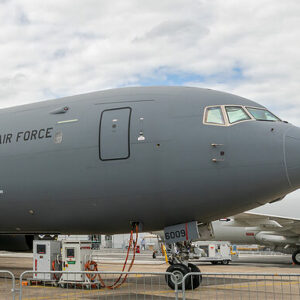As the U.S. shifts focus to near-peer competition with Russia and China, the need for investment in aerial refueling has never been greater. Modern aerial refueling capabilities are critical to the success of the Air Force’s worldwide missions in any conflict. Airplanes that can be refueled in-flight have longer operational reach and more time in the fight, thanks to tanker aircraft. As a former KC-135 pilot, I’ve seen firsthand how vital this capability is.
The Air Force is in the process of modernizing its tanker fleet in a multi-phase approach. The first phase began a decade ago with the decision to buy 179 next-generation KC-46A Pegasus tankers. When the 179th tanker is delivered in 2029, the Air Force will still be flying hundreds of Eisenhower-era KC-135s that must be replaced.
In Phase Two, the Air Force will buy an additional 160 tanker aircraft similar to the KC-46A — manned, wide-body aircraft carrying fuel, passengers and cargo. Only two aircraft on the market today fit that description — Boeing’s KC-46A and the “LMXT,” a proposed modification of Europe’s Airbus tanker.
Senior Air Force officials have said the KC-46A is performing well and are leaning toward buying another round of them. That makes sense. It is already integrated within the U.S.’s active-duty Guard and Reserve forces. Air crew and maintenance training are up and running, and base support and infrastructure are in place.
The critical linchpin of aerial refueling in combat is the ability to have as many tankers available as possible, spread across multiple strategically located refueling locations. This puts tankers as close as possible to the fighters, bombers and other combat aircraft that need to refuel, wasting as little precious fuel as possible.
Widely dispersed aircraft are also much harder for an adversary to attack. The agile Pegasus is perfect for this environment and has proven itself in austere conditions. The Airbus LMXT is much larger and heavier, requiring more fuel and larger facilities. Those characteristics are unwelcome in today’s environment.
Adding the Airbus LMXT to the Air Force inventory would also require additional training operations that, along with other program start-up costs, could add billions of dollars in unnecessary spending.
The pandemic demonstrated the vulnerabilities in the U.S. supply chain and our dependence on foreign nations for critical components. Our national security cannot depend on other countries, particularly in times of crisis. The KC-46A has a well-established, reliable American supply chain already in place. Continuing KC-46 production is the quickest, most efficient and cost-effective way to get highly capable new tankers into warfighter’s hands.

